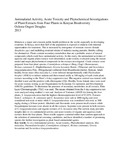Antimalarial Activity, Acute Toxicity And Phytochemical Investigations Of Plant Extracts From Four Plants In Kenyan Biodiversity
Abstract
Malaria is a major and constant public health problem in the world, especially in developing
countries. In Kenya, more than half of the population is exposed to malaria with minimal
opportunities for treatment. This is increased by emergence of resistant vectors (female
Anopheles spp.) and multidrug-resistant strains of malaria causing parasite, thereby calling
for alternatives. Plants contain secondary metabolites that are a probable source of natural
compounds which could have antimalarial activity. In this study, the antimalarial activities of
aqueous and organic plant extracts were determined, acute toxicity evaluated using the mouse
model and major phytochemical compounds in the extracts investigated. Crude extracts were
prepared from four plant species; Commiphora schimperi (Berg.) Engl. (Burseraceae),
Ricinus communis L. (Euphorbiaceae), Grewia hexamita Burret. (Tiliaceae) and Securidaca
longependuculata Fres. (Polygalaceae) collected from Msambweni district, Kenyan. Adult
healthy Swiss mice (Mus musculus L.) were infected intraperitoneally with Plasmodium
berghei (ANKA) to induce malaria and then treated orally at 100 mg/kg of each crude plant
extracts according to the Peter’s 4-day suppressive test. The negative control was treated with
distilled water and the positive with chloroquine (CQ). Healthy Swiss female mice were used
for acute toxicity testing as per Organisation for Economic Co-operation and Development
(OECD) guidelines. To determine the presence of secondary metabolites in all extracts, Thin
Layer Chromatography (TLC) was used. The means obtained from the 4-day suppressive test
were analyzed using student’s t-test and Analysis of Variance (ANOVA).Among the four
plants, S. longependuculata had the highest chemosuppression level of 91.03%. Extracts
from C. schimperi, R. communis and G. hexaminta were safe at 2000 mg/kg and were
considered non toxic to mice while S. longependuculata was considered non toxic at 300
mg/kg during a 24 hour period. Alkaloids and flavonoids were present in all extracts while
Sesquiterpene lactones were absent in all the extracts. Saponins were present in both extracts
of S. longependuculata and organic extracts of G. hexamita only.The current study provides
insights into in vivo antimalarial activity and acute toxicity of organic and aqueous crude
extracts from the four plants. These results support a rational rather than random approach to
the selection of antimalarial screening candidates, and have identified a number of promising
species for further investigation as plant based antimalarial agents.
Citation
Master of Science in Plant Physiology and BiochemistryPublisher
University of Nairobi School of Biological Sciences
Subject
In vivo Antimalarial activityAcute toxicity
Phytochemical analysis
Musculus
Plasmodium berghei
Commiphora schimperi
Ricinus communis
Grewia
Hexaminta
Securidaca longependuculata

